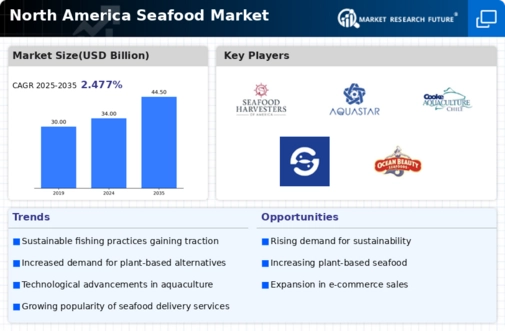The North America Seafood Market is characterized by a dynamic competitive landscape shaped by evolving consumer preferences, sustainability initiatives, and technological advancements. Growing demand for healthy protein sources and seafood options has intensified the competition among businesses looking to secure market share. Companies in this sector are increasingly focusing on innovative product offerings, enhanced supply chain practices, and sustainable fishing practices to differentiate themselves. The rise of convenience products and ready-to-eat meals has created new avenues for growth, leading to a more competitive environment where firms must continuously adapt to stay ahead.
In addition, regulatory frameworks and trade policies further influence market dynamics, requiring companies to remain agile and responsive to shifts in consumer trends and external factors.North Atlantic Sea Farms has established a notable presence in the by focusing on sustainable aquaculture practices and innovative farming techniques. The company's strengths lie in its commitment to producing high-quality, environmentally friendly seafood, which resonates well with the increasing consumer preference for sustainable food sources. By leveraging advanced farming technology and employing responsible sourcing methods, North Atlantic Sea Farms has positioned itself as a leader in the sustainable seafood segment.
Their robust market presence is bolstered by partnerships with local retailers and restaurants, ensuring that their products reach consumers efficiently while emphasizing quality and freshness. Their efforts in sustainability also align with broader environmental initiatives, enhancing their brand reputation within a market increasingly concerned with ocean health and biodiversity.Mowi ASA is a prominent player in the , known for its extensive product offerings, which include fresh, frozen, and value-added seafood products. The company has carved a significant niche for itself through its commitment to high standards of quality and sustainability.
Mowi ASA's strengths lie in its well-established supply chain, efficient production processes, and a strong emphasis on responsible fish farming practices. This has allowed the company to maintain a competitive edge in delivering premium seafood products to consumers across North America. Additionally, Mowi ASA has pursued strategic mergers and acquisitions to expand its operational capabilities and market reach, enhancing its portfolio of services. The company's proactive approach to sustainability and innovation while consistently investing in R&D allows it to meet the evolving preferences of North American consumers, positioning it well for future growth in the seafood sector.
















Leave a Comment